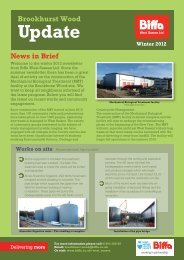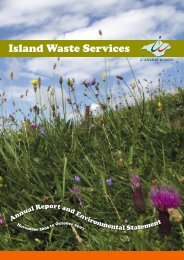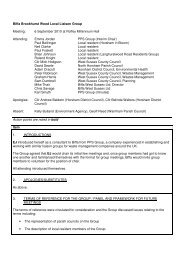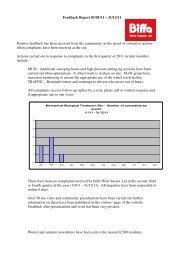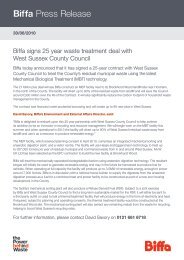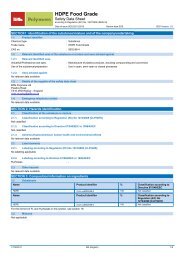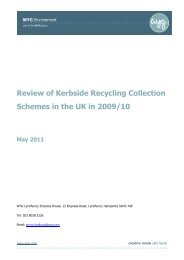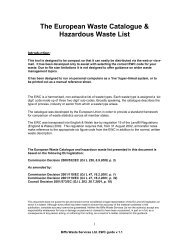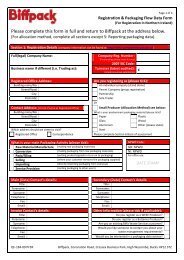detailed explanation for each SIC code - Biffa
detailed explanation for each SIC code - Biffa
detailed explanation for each SIC code - Biffa
Create successful ePaper yourself
Turn your PDF publications into a flip-book with our unique Google optimized e-Paper software.
Introduction<br />
A Standard Industrial Classification (<strong>SIC</strong>) was first introduced<br />
into the UK in 1948 <strong>for</strong> use in classifying business<br />
establishments and other statistical units by the type of<br />
economic activity in which they are engaged. The classification<br />
provides a framework <strong>for</strong> the collection, tabulation,<br />
presentation and analysis of data, and its use promotes<br />
uni<strong>for</strong>mity. In addition, it can be used <strong>for</strong> administrative<br />
purposes and by non-government bodies as a convenient way<br />
of classifying industrial activities into a common structure.<br />
Classification changes<br />
Since 1948 the classification has been revised in 1958, 1968,<br />
1980, 1992, 1997, and 2003. Revision is necessary because,<br />
over a period of time, new products and new industries<br />
to produce them emerge, and shifts of emphasis occur in<br />
existing industries. It is not always possible <strong>for</strong> the system<br />
to accommodate such developments and, after a period of<br />
time, updating the classification is the most sensible action.<br />
The 1997 and 2003 changes were not full-scale revisions<br />
but responses to user demand <strong>for</strong> additional detail at the<br />
subclass level together with some minor renumbering and<br />
revisions. This latest publication is a major revision reflecting<br />
contemporaneous changes in NACE (see next paragraph).<br />
The need <strong>for</strong> change equally effects all international<br />
classifications and they are revised from time to time to<br />
bring them up to date. On 9 October 1990 the European<br />
Council of Ministers passed a regulation to introduce a new<br />
statistical classification of economic activities in the European<br />
Communities (NACE Rev. 1). In January 2003, a minor revision<br />
of NACE Rev. 1, NACE Rev. 1.1, was published 1 followed by a<br />
major revision, NACE Rev. 2, effective from 1 January 2008 2 .<br />
International classifications<br />
From the outset, the UK <strong>SIC</strong> followed the same broad<br />
principles as the relevant international systems. UK statisticians<br />
played an important part in the <strong>for</strong>mulation of the first I<strong>SIC</strong><br />
(International Standard Industrial Classification of All Economic<br />
Activities), issued by the United Nations in 1948 and revised in<br />
1958, 1968, 1989, 2003 and now in 2008. Nevertheless, there<br />
were differences in detail between the two as I<strong>SIC</strong> reflected<br />
the structure of economic activity in the world as a whole<br />
rather than that in one particular country.<br />
In 1980, one of the principal objectives of the revision of<br />
the <strong>SIC</strong> was to examine and eliminate differences from the<br />
activity classification issued by the Statistical Office of the<br />
European Communities (Eurostat) and entitled Nomenclature<br />
générale des activités économiques dans les Communautés<br />
européennes, usually abbreviated to NACE. This 1970 NACE<br />
could be rearranged to agree with I<strong>SIC</strong> at aggregated levels but<br />
departed from it in the details. The 1980 revision of the <strong>SIC</strong><br />
applied NACE as closely as was practicable to the structure of<br />
British industry.<br />
In 1990, however, the first revision of NACE was made by EC<br />
regulation and this presented a different set of circumstances.<br />
EC regulation<br />
A European Community regulation is directly applicable<br />
in all member states. It does not have to be confirmed by<br />
national parliaments in order to have binding effect. The<br />
NACE regulation, there<strong>for</strong>e, made it obligatory on the UK to<br />
introduce a new Standard Industrial Classification, <strong>SIC</strong> (92),<br />
based on NACE Rev. 1, and to use it where the UK is required<br />
to transmit to the European Commission statistics on economic<br />
activity.<br />
The NACE regulation gives effect to the wish of Eurostat<br />
to establish a common statistical classification of economic<br />
activities in order to promote comparability between national<br />
and Community classifications and, there<strong>for</strong>e, between<br />
national and Community statistics. The regulation applies<br />
to the use of NACE <strong>for</strong> statistical purposes only, although a<br />
country can also use NACE <strong>for</strong> administrative purposes. The<br />
regulation does not oblige member states to collect, publish<br />
or supply data. NACE is only a language and all requests <strong>for</strong><br />
data collection, transmission and publication must be specified<br />
elsewhere. As noted already, there is now a new version of<br />
NACE, NACE Rev. 2, effective from 1 January 2008.<br />
As already indicated, NACE was originally an acronym but now<br />
all countries use ‘NACE’ to describe the European Community<br />
classification of Economic Activities.<br />
UK <strong>SIC</strong> structure<br />
The UK <strong>SIC</strong> is based exactly on NACE but, where it was<br />
thought necessary or helpful, a fifth digit has been added to<br />
<strong>for</strong>m subclasses of the NACE four digit classes. Thus, the UK<br />
<strong>SIC</strong> is a hierarchical five digit system. UK <strong>SIC</strong> (2007) is divided<br />
into 21 sections, <strong>each</strong> denoted by a single letter from A to U.<br />
The letters of the sections can be uniquely defined by the next<br />
breakdown, the divisions (denoted by two digits). The divisions<br />
are then broken down into groups (three digits), then into<br />
classes (four digits) and, in several cases, again into subclasses<br />
(five digits). So <strong>for</strong> example we have:<br />
1



